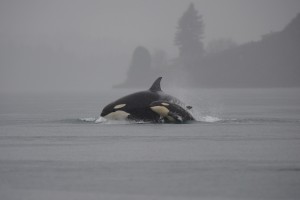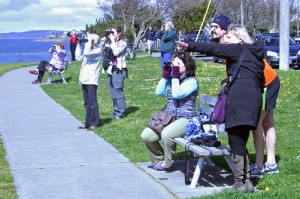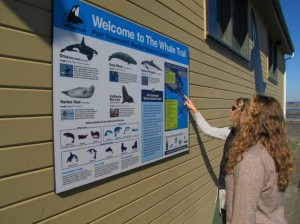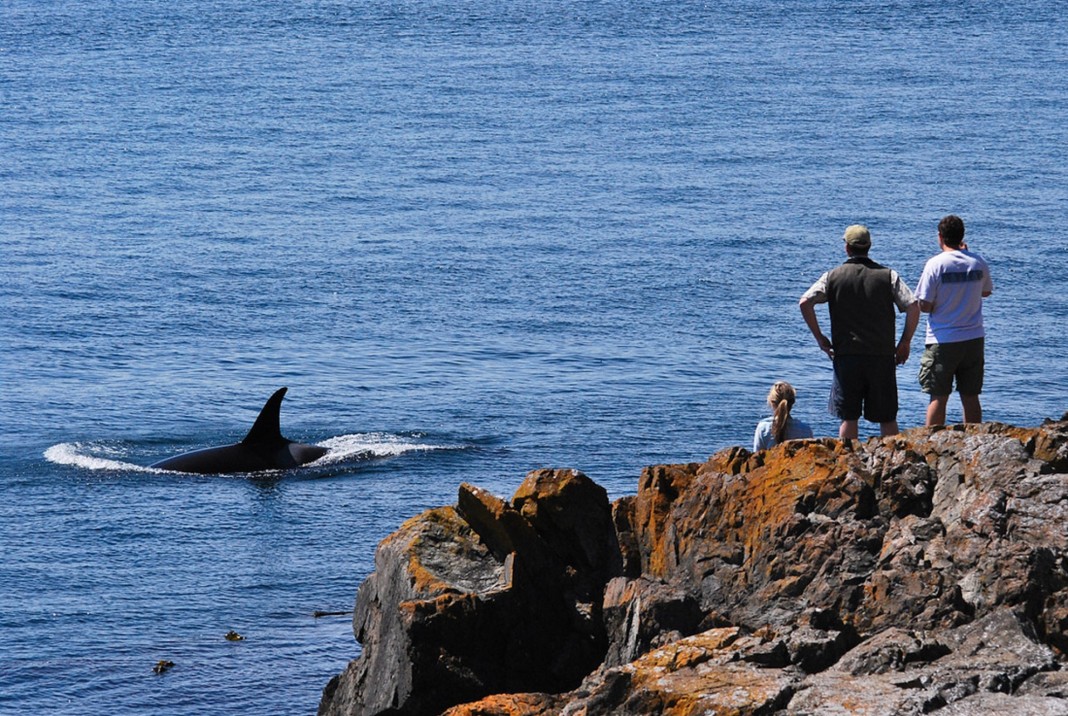In the Pacific Northwest, elk, otters and eagles aren’t the only fauna that travelers are likely to spot out on the trail. Many routes along Washington’s ocean shores offer a great place to spy some of the biggest wildlife around: whales.
 The Pacific and Puget Sound coastlines are ripe with footpaths along shorelines and buttes where gray, orca and humpback whales are commonly counted among the indigenous residents at dozens of sites. Some of these whale-rich waters — like Cama Beach State Park — even offer some cozy beachside accommodations for spout-spotters.
The Pacific and Puget Sound coastlines are ripe with footpaths along shorelines and buttes where gray, orca and humpback whales are commonly counted among the indigenous residents at dozens of sites. Some of these whale-rich waters — like Cama Beach State Park — even offer some cozy beachside accommodations for spout-spotters.
If you’ve got whales on the brain, now’s the time to scratch that itch. March, April and May are the best months for Pacific Northwesterners to spot gray in migration from Baja, California. Orca whales love the cold waters of Puget Sound and can be seen from April to September from the beaches that border some of Washington’s most popular state parks. Check in with any of the parks and trails on the map below to spot your fill of spouts this summer.
Island Spout Spotting
While it’s possible to see whales near the waters surrounding Vashon Island and Seattle, the northern islands that surround Puget Sound are most commonly counted among the best spots to watch for whales. San Juan Island and Orcas Island, in particular, offer many options for boat-based whale watching opportunities. For those who want to try their hand at watching from shore, Lime Kiln State Park is a mecca of pod sightings. May through September is the busiest season for whale watchers, with June and July being the most likely to sight a whale from shore. Explorers can catch a glimpse of these oceanic commuters from almost anywhere on Lime Kiln’s shore. A convenient watch spot, fortunately, is located in the state park’s parking lot not far from the ferry terminal. Minke whales, Dall’s porpoises, and harbor porpoises also frequent this area, and Humpback whales and Pacific white-sided dolphins pass through on occasion, too.

Once you’ve had your fill of watching for wildlife from this vantage point, follow the short trail to another Haro Strait overlook: the Lime Kiln Lighthouse, built in 1919. During the peak season, orca pods may pass by this overlook as many as three times a day, and they are easy to spot from this vantage point. Not far from here, you can continue on to inspect the lime kiln furnace that was a major part of the San Juan Island industry in the 19th and early 20th centuries. This short hike is only 1.25 miles round trip, leaving you with plenty of vim and vigor should you decide to explore more than one site in a day.
Built originally as a coastal defense fort in World War II, Fort Ebey State Park on Whidbey Island overlooks the Strait of Juan de Fuca, where whales must pass to reach the Puget Sound. This park offers some wonderful trails that overlook the shoreline as well as marked paths for hiking and biking. You’ll spot not only some stray spouts along the coast but also some fantastic views of the Olympic Mountains as you ramble along through the beach and forest.
Keep your eyes peeled for whales along the trail to Ebey’s Landing as you pass along the windy ridge that overlooks Whidbey Island. Visitors can take the Bluff Trail by way of the Ebey’s Landing parking lot for a shoreline amble or approach from the Prairie Overlook for a more traditional hiking experience. The Overlook offers sweeping views, a few switchbacks, and some sweeping vistas that are well worth the effort to the summit and the descent to the beach below.
Not situated on an island but still located a fair distance away (not far from the Oregon border), Cape Disappointment State Park on the Long Beach Peninsula is the only location in Washington that participates in Oregon’s Whale Watching Spoken Here program. That means visitors can more easily find land-based whale-watching opportunities courtesy of volunteer-led guides and experts who are familiar with the whale activity in the area. The interpretive center offers a glass observation deck, which boasts views of the Columbia River and the Pacific Ocean that make for some fantastic whale-watching opportunities.
There are a handful of short but scenic trails at Cape Disappointment, which is home to two lighthouses and was once the site of the Fort Canby military reservation. A popular whale-watching spot, North Head, is a nearly 2-mile trek that concludes at the North Head Lighthouse. Return the way you came for a scenic 4-mile out-and-back jaunt.
Make a Day of It: Whale Spotting Along the Olympic Coast

Donna Sandstrom, founder and executive director of the Whale Trail, explains that one of the best ways to take in Washington’s majestic marine life is to take a day-trip along the Olympic coast. Trace the shoreline to get the most of your whale-watching experience and hit one, two or maybe all of the sites listed below for an excellent opportunity to view some of Washington’s most magnificent wildlife between March and May.
From the 101 N outside of Seattle, your first stop will be Kalaloch Beach. The word Kalaloch translates in the language of the indigenous Quinault Indians as a “good place to land,” and whale watchers won’t find it hard to see why as they explore the area. Beyond its sandy beaches, Kalaloch boasts two campgrounds, self-guided nature trails and acres of evergreens in the forests that rise past the driftwood-strewn shore. Steep bluffs and hidden coves offer explorers more to look for aside from migratory pods; the trek to Browns Point at low tide offers opportunities to explore tidal pools and caves that bore into Kalaloch’s cliffs. Continue on to hike along Beaches Three and Four, Ruby Beach or the Mouth of the Hoh River for even more opportunities to take in the scenery while you’re watching for whales.
Continuing on along the coast, the beaches of La Push serve as the stage of an annual migration of nearly 18,000 gray whales as they move along the Pacific Coast. The Quileute Tribe hosts an annual Welcoming of the Whales Ceremony in April each year, making this time of year a perfect opportunity to sojourn to the Olympic coast.The First Beach shoreline is a wonderful to place to check for spouts along the ocean’s edge. For those who are interested in taking in a hike to break up their adventure, the trails to the First, Second and Third Beach Trails make for a trio of beautiful shoreline ambles all located in the center of whale watching country.
At the northwest tip of the contiguous United States, Cape Flattery is located on the Makah Nation at Neah Bay. The Cape Flattery Trail, which leads to a lookout platform offering stunning views of wildlife and landscapes, is a 3.5-mile route that leads adventurers to the tip of the Cape. At the trail’s end, enjoy views of sea otters and gray, orca and other whales as they hunt and play between the Cape, the Strait of San Juan de Fuca and Tatoosh Island. If you have time, visit the Makah Museum and Cultural Center. Here you can listen in on a series of hydrophones placed strategically around the Sound for signs of nearby pods. To scratch your itch for exploring, the 12-mile out-and-back Cape Flattery Scenic Byway and shorter 1.2-mile Cape Flattery Trail offer two options to stretch your legs.

Not far from the Salt Creek Recreation Area are two hikes: the popular Spruce Railroad Trail, a 4-mile point-to-point hike and Striped Peak Trail, a 5-mile round-trip trek that explores forested land and summits with a beautiful overlook of the coast on clear days. Orcas, minkes and occasionally humpback whales can be spotted from various vantage points on this marine sanctuary. One of the best spots to spy for signs of ocean life is distinguished easily thanks to the Whale Trail marker located near the stairs that lead up to the Tongue Point overlook.
Snow Creek is the one of the most northernmost spots for whale watching in the Olympics. The wealth of wildlife to be found along the strait of Juan de Fuca offers a spectacular opportunity for nature watching. Migrating gray whales stream by in spring, and a few spend all year feeding in the strait. After a day watching whales and wildlife, visitors can make for the Snow Creek Resort or its on-site camping facilities and reward a full day of whale watching with a relaxing night under the stars or in a family-friendly suite. The region offers pastoral views of the Strait of San Juan de Fuca, Neah Bay and the Pacific coastline, and is a popular spot to kayak, canoe and fish. Here you will have an excellent vantage point to spot the flukes of gray whales, orcas, harbor seals and sea otters. For year-round hiking opportunities, check out the Shi Shi Beach Trail and the Point of Arches, a moderate 8-mile roundtrip route that explores the woodlands and area along the shore and features scenic wildflowers in bloom.
Special thanks to the Whale Trail, a not-for-profit organization dedicated to inspiring appreciation and stewardship of whales and our marine environment, for help in compiling a convenient route of viewing sites throughout Puget Sound and the coastal waters of the Pacific Northwest.














































